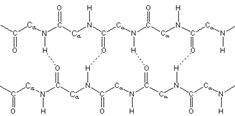In this video, we're going to begin distinguishing between antiparallel and parallel beta sheets. Now, you might be wondering why talk about antiparallel beta sheets before we talk about parallel beta sheets? Well, it turns out that the antiparallel beta sheets are actually easier than the parallel beta sheets. So, we'll talk about the easy stuff first, and then we'll talk about the harder stuff later. And so, with the antiparallel beta sheets, it turns out that the beta strands are going to be aligned in opposite directions in terms of their N- and C-terminal ends. And the rise per residue for an antiparallel beta sheet is, to no surprise, 3.5 angstroms since we said in our previous lesson videos that beta sheets have a rise per residue of 3.5 angstroms. And so, down below in our example, it's pretty clear to see that this image on the left here is an antiparallel beta sheet. And so, we can see that we have a single polypeptide chain that's all connected to one another, and these arrows here represent beta strands. And the beta strands that are adjacent to one another, right next to another, are pointing in opposite directions. And so, when they're pointing in opposite directions, in terms of their N- and C-terminal ends, that identifies them as being antiparallel beta sheets. And so, we know that the arrows are pointing towards their C-terminal end. And because this is the beginning of the chain, this is the N-terminal end, and the arrows pointing towards the C-terminal end are going to make this the C-terminal end over here. And again, because this is one continuous polypeptide chain, that makes this an intrachain antiparallel beta sheet.
Moving on to the parallel beta sheets, in contrast, the beta strands are actually aligned in the same direction in terms of their N- and C-terminal ends instead of the opposite direction. And the rise per residue for a parallel beta sheet is actually a little bit more condensed. It's 3.2 Å. And so, even though 3.2 Å is a little bit more condensed, it's still, in comparison to an alpha helix, a lot more extended. Because an alpha helix has a rise per residue of 1.5 angstroms. So that's really really condensed. 3.2 Å is all very extended in comparison to the alpha helix. It's just that this antiparallel beta sheet is a little bit more extended than the parallel beta sheet. So, something interesting to keep in mind. And so down below on the right, we have an image of the parallel beta sheet and we can tell because the beta strands are all pointing in the same direction in terms of their N- and C-terminal ends. And so, this is one continuous polypeptide chain here, so we know that this is an intrachain parallel beta sheet. And this is the back of the arrow over here, so this will be the N-terminal end. And this is what the arrows are pointing to, so this is the C-terminal end. And so this concludes our initial lesson on the differences between antiparallel and parallel beta sheets. In our next lesson video, we're going to be able to talk even more differences between these two, specifically the hydrogen bonding differences between the two. But before we get there, let's get some practice. So I'll see you guys in that practice video.




